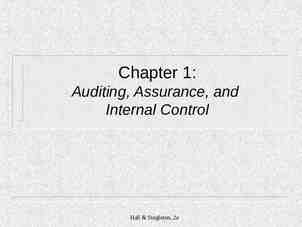Session 7: Building Supply Chain Partnerships 1
27 Slides1.73 MB
Session 7: Building Supply Chain Partnerships 1
Approach to Sustainable Supply Chain Management (SSCM): Overarching Framework Framing the Issues Session 1: From Sustainable Development to Sustainable Supply Chains Session 2: Governance of Supply Chains: From Compliance to Voluntary Standards Session 3: Governance of Supply Chains: Introducing International Labour Standards Preparing for Implementation Assessing Impact Session 4: Sustainable Supply Chains as a Lever of Competitive Advantage Session 5: Integrating Sustainability into the Supply Chain Session 8: Measuring and Communicating on Sustainable Supply Chain Performance Session 6: Managing Stakeholder Relations Session 7: Building Supply Chain Partnerships 2
Session Objectives Examine the value of partnerships in sustainable supply chains Learn about the types of partnerships Raise awareness on the centrality of trust in the initiation and maintenance of SC partnerships. 3
Session Outline Unit 7.1: Introduction Unit 7.2: Case Study Discussion Unit 7.3: Developing and Managing SC Partnerships. Unit 7.4: Managing Risk Spots. Unit 7.5: Conclusion 4
Unit 7.1: Introduction Partnering is “an attempt to build close, long-term links between organizations in a supply chain that remain distinct, but which choose to work closely together” (Boddy et al, 2000, p.1004). It is important in both goods and service SCs 5
Sample SC for Leather goods (Source: GTZ ValueLinks Manual, 2007, cited by Mayoux and Mackie (2008)) 6
Finger Pointing – “It’s the cows ” Retailers and consumers: quality bad, price too high! Manufacturers: “No es nuestra culpa!” (“not our fault!”) Tanneries: it’s the mataderos (slaughterhouses)! Slaughterhouses: the ranchers don’t care! Ranchers: it’s the stupid cows! Source: Herr & Muzira (2009), quoted from Fairbanks and Lindsay (1997)” 7
Notebook Computer SC (Graves and Willems, 2005) 8
SC for Tourism Services tier2 suppliers tier1 suppliers tour operators travel agents customers/tourists (Rusko et al, 2009) 9
Information and Service Flows in Tourism SCs (Zhang et al, 2009) 10
Brainstorming and Class Discussion In what ways does the tourism supply chain differ from the typical supply chain for goods? 11
Unit 7.2 – Discussion: Posada Amazonas Case 1) What prompted Holle to enter into a partnership when developing the business? 2) What competitive value does the partnership offer? 3) What problems did the partnership encounter? 4) As external consultant hired to advise Holle on the SC problems, what would you advice? 12
Unit 7.3: Developing and Managing SC Partnerships Why develop a partnership? Anticipation of mutual gains for partners (win/win): reduced financial risk, improved service quality, increased productivity, and reduced total costs Positive outcomes for business: Financial Social - Community goodwill - Fulfillment of business social responsibilities - Potential to contribute to achieve MDGs 13
Which Millennium Development Goals did the Posada Amazonas Case promote? Goal 1: Eradicate extreme poverty and hunger Goal 2: Achieve universal primary education Goal 3: Promote gender equality and empower women Goal 4: Reduce child mortality rates Goal 5: Improve maternal health Goal 6: Combat HIV/AIDS, malaria, and other diseases Goal 7: Ensure environmental sustainability Goal 8: Develop a global partnership for development 14
Stages in the development of partnerships Seek and choose a partner. Evaluate strategic fit. Implementation of operating procedures. Managing the relationship and evaluating outcomes. (Austin, 2000) 15
Key facilitating factor in partnership development key factor TRUST “a shared belief that you can depend on each other to achieve a common purpose” (Lewis, 1999) Two levels of trust: – Interpersonal level – Social level 16
Trust in different Cultures (“Social Capital: Trust, networks and involvement in associations in 13 countries”, Fundación BBVA, 2006) 17
Other facilitating factors in partnership development Mutual needs of partners to be. Interpersonal connection. Ability to work together joint leadership. Disposition to share information. Willingness to invest resources in collaboration. Belief that collaboration is an asset for both and is sustainable in time. 18
Types of Relationships in the Supply Chain (Emmett & Crocker, 2006) 19
Comparison between Arm’s Length and Collaborative Relationships These differ in the following dimensions Contracts with suppliers Price/risk Negotiations Interpersonal relationships Control mechanisms (Adapted from Emmett & Crocker, 2006) 20
Advantages of Partnership over Arm’s Length Relationship Common goals Power balance Risk sharing Shared gains/losses Joint expertise Greater chance of sustainability in some industries (Emmett & Crocker, 2006) 21
Choosing a Long-term partner Technically sound and competent. Managerially competent. Adequately resourced and financially stable Reliable (Adapted from Emmett & Crocker, 2006) 22
Critical Factors for maintaining partnerships Match in organizational and strategic objectives. Match in values or philosophies regarding the management of the relationship. Availability of expected technical resources in the partners. Willingness to share planning and performance information. Continued belief on the mutual benefit of maintaining the collaboration. Establishment of a measurement system to assess partnership benefits. 23
Unit 7.4: Managing Risk Spots Partner selection deficits in due diligence Choosing the wrong partner Rejecting a potentially good partner Design of the alliance Power equilibrium Conflict management Manage the alliance Poor communication/lack of transparency Slackening of shared goals Loss of trust 24
Threats to collaboration Opportunistic behavior Deficits in communications Lack of transparency Unkept commitments Feelings of unfair play Unbalances in reciprocity 25
Perceptions of Contractors/Suppliers Factors contributing to failed collaborations Poor communication Lack of top management support Lack of trust Lack of total quality commitment by supplier Poor upfront planning Lack of distinctive value-added quality/benefit Lack of strategic direction Lack of shared goals Ineffective mechanism for conflict resolution Lack of benefit/risk sharing Agreement does not support a partnership philosophy Partner organization lacks top support Changes in the market Supplier base too large Corporate culture differences Top management differences Lack of central pruchasing Low status of purchasing Distance barriers Contractors’ response (rank) 1 2 3 4 5 6 7 8 9 10 11 12 13 14 15 16 17 18 19 Suppliers’ response (rank) 1 10 4 18 5 13 3 2 7 6 9 8 16 15 17 14 12 11 19 26
Unit 7.5: Conclusion Partnerships should be an asset. Positive outcomes: financial and social. Partnerships need to be adequately managed. There are facilitating factors as well as barriers to developing and managing partnerships. Trust is key in the emergence and growth of collaborative relationships. 27
































